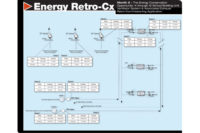Last month, we tested readers on commissioning three of the many automatic temperature control (ATC) sequences of operation associated with outdoor air ventilation, space cooling, and also no mechanical heating or cooling required. This month’s Back2Basics is to air balance each room heat pump and the 100% OA ventilation system, and to test readers on balancing these systems at maximum design air flow during the air-conditioning season. Not included in this test are the following testing, adjusting, and balancing (TAB) requirements:
- Water balance building-side condenser water design water flow to each heat pump
- Water balance building-side condenser water primary equipment (cooling tower and heat exchangers with associated pumps)
- Air balancing of the building exhaust systems
The energy retrocommissioning team continues to include the facility manager; ATC operator; commissioning engineer; TAB engineer; and if possible, a LEED-accredited professional. Going forward, the team, and more specifically the facility manager, will continue to be responsible for collecting the incoming utility bills and measure them to the past utility bills to compare the difference in energy usage.
We discussed three prerequisites to pursuing energy retrocommissioning opportunities in the past, which are:
- Collect the utility bills and convert the energy used into Btuh/sq ft/yr.
- Based on the results, if it makes good business sense, proceed further with a potential energy retrocommissioning opportunity.
- Equally important is the documenting of the basis of design (BofD) for the original HVAC design and the future HVAC design (once the energy retrocommissioning solution plan is mutually agreed upon).
To complete this month’s TAB tasks, the TAB engineer shall complete the following:
- Document the 100% OA ventilation system performance so as to be able to benchmark and document air flow balancing improve-ments when comparing the existing/actual airflow data to the new energy retrocommissioning basis of design.
- Document the individual heat pump system performance so as to be able to benchmark and document air balancing improvements when comparing the individual existing heat pump units to the new energy retrocommissioning results.
- Document the existing central condenser water heat pump water system performance so as to be able to benchmark and document water balancing improvements when comparing the existing systems to the new energy retrocommissioning results (not part of this test).
- Document the individual heat pump circuits so as to be able to benchmark and document water balancing improvements when comparing the individual existing heat pump units to the new energy retrocommissioning results (not part of this test).
- Create system flow diagrams for the retro-commissioned 100% OA ventilation system incorporating pertinent operating data (i.e., internal static pressure drops, external static pressure drops, and summarizing the two to determine system total static pressure) along with each heat pump’s internal, external, and total static pressure drops.
- With water-source heat pumps located in an occupied room and/or adjacent to an occupied room (e.g., above the room’s ceiling), it is also recommended that equipment and room sound readings be taken to assure that these heat pumps are not generating loud/distracting noise relative to the occupied space.
Before the TAB engineer can complete the flow diagram, she must also review the existing basis of design document to clearly understand how the system was/is to work. It is important to note the TAB engineer may complete the air flow readings in sync with the commissioning engineer completing his ATC/FPT pass-fail documentation (see last month’s B2B for example).
The TAB engineer should review record drawings, existing equipment shop drawings, and if necessary make a “best guess” as to the original design calculations (e.g., pressure drop across the direct expansion coils) based on her experience with air system pres-sure drops. This information is inputted into the TAB system flow diagram TAB-3 process to document the estimated “design” pressure drop readings. Next, the TAB engineer picks up the tools and completes the air system readings, documenting the actual flow, pressure drop, and velocity and note this data on the design-to-actual TAB flow diagram. Now the auditors have design-to-actual data to analyze.
This month’s test is for you to select the correct answers in each of the remarks column next to each air pressure drop reading. Refer to the B2B page two TAB system flow diagram and note design-to-actual findings. The answers can be found at www.esmagazine.com.
When coordinating the ATC/FPT-TAB initiative, the energy retrocommissioning team should use an equipment assessment checklist to complete a static condition assessment of the equipment/system and to also identify energy retrocommissioning opportunities. Any deficiencies identified via the checklists need to be added to the energy retrocommissioning master corrective action log along with the commissioning engineer’s corrective action finds. It is also important to note that the auditors should not assume there were no previous installation problems that were never identified prior to the building owner accepting the outdoor air ventilation system, primary water-source heat pump system, and the individual room heat pumps installation. These deficiencies may be an integral part of the energy retrocommissioning issues and concerns and may have compromised system performance and wasted energy in the past.
With data analysis phase and solution planning phase completed, the energy retrocommissioning team can reformat the corrective action log into a energy conservation measure (ECM) report for presentation to those funding the energy retrocommissioning project.






